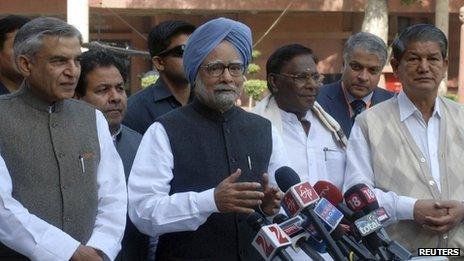Low expectations from India's budget
- Published

The prime minister is hemmed in by high inflation and a drop in economic growth
In India the annual budget presentation by the finance minister is not just a statement of accounts but also an occasion to signal the broader policy intent of the government.
This year's budget to be presented on 16 March has a special significance given the difficult economic and political circumstances that Prime Minister Manmohan Singh's government is grappling with.
Consequently, the budget presentation is being seen as a test of the political resolve of Mr Singh's Congress party-led United Progressive Alliance to implement much-needed reforms to rescue an economy whose growth rate plummeted to 6.1% in the third quarter of the financial year 2011-12.
No one, not least the reputed government economists who advise the prime minister, expected growth in Gross Domestic Product to fall so dramatically.
The previous two quarters had averaged GDP growth of 7.3% and based on this trend the prime minister's Economic Advisory Council last month projected growth for the entire year of 7.1%.
Of course, now 7.1% looks like a tall order as the third quarter's dismal performance will drag annual GDP growth to possibly around 6.5%.
Sleepless nights
This makes Finance Minister Pranab Mukherjee's job even more difficult because falling growth will make other key budget estimates, like revenue growth, go haywire.
If the economy does not grow at the desired pace, how will the government pay for the vast and growing welfare programmes it has already committed to?
Finance minister Mukherjee said he was having sleepless nights over the leakage of massive subsidies that the government was paying year after year.
This year the fiscal deficit (the excess of expenditure over revenues) could be over 6% of GDP, as against the budgeted 4.6%, if all the hidden oil subsidies are taken into account.
In a perverse policy practice, public sector oil companies absorb nearly 50% of the oil subsidies the government provides for diesel, kerosene, cooking gas and petrol.

A slowdown in rural consumption has hampered India's economic growth
Why is the government subsidising middle class users of cooking gas and diesel vehicles is something for which no rational explanation is forthcoming.
The actual oil subsidies, explicit and hidden, could be in the order of $30 billion this year, up from less than $10 billion in 2009-10.
This figure has multiplied because international oil prices have been climbing relentlessly and the government does not adjust domestic prices automatically, fearing a political backlash.
So domestic oil prices remain unadjusted for long periods, especially in the run up to assembly elections, whether in West Bengal or Uttar Pradesh.
The oil subsidies are the single biggest cause for the deterioration of government finances. They are the elephant in the room which the UPA does not want to see.
Catch-22
Food and fertiliser subsidies account for another $20 billion. This will grow further as the government is about to legislate a food security bill which will deliver subsidised food grains to nearly 70% of India's population.
Another worry is if the higher international oil prices are fully reflected in domestic oil prices, India's inflation rate could rise by as much as 3.6% from the present average level of 8-8.5%.
So by shifting a large part of the oil subsidy payout onto the books of public sector oil companies, the government is understating the inflation rate substantially.
Thus, the budget is being prepared against a real macro-economic situation that is far from stable.

Investment in Indian coal mines has dropped off recently
In spite of these headwinds, both domestic and global investors are looking to this budget to deliver fiscal consolidation, contain subsidies and provide new measures for raising revenues.
This is the Catch-22 situation the government is caught in.
Data shows that the savings rate in the economy is steadily slipping back to about 32% of GDP from more than 36% in 2008.
The growth of private investment in the economy is down to the low single-digit level. Many analysts attribute this massive slowdown in private investment by companies to the negative sentiment generated by the policy inaction on the government's part.
This is exemplified by declining investment in the mining sector, including coal. How can the economy grow if coal production growth is in decline?
While private investment is down, there are also signs that consumption growth is slowing quite sharply.
India's rural consumption was quite robust in the two years after the 2008 global economic crisis, keeping GDP growth at 8.4% in 2010-11.
The finance minister will have to worry about this decline in consumption growth too while formulating his budget.
It all means that the UPA will have to roll out some real bold measures to boost the economy.
But will it be able to?
Promises
Many of the reforms, like foreign investment in retail, which were put off until the Uttar Pradesh elections were held will have to be taken up afresh.
The prime minister is on record promising this; the market is expecting this and other reforms to be brought to bear.
However, there are signs that bold reforms like the implementation of a Goods and Services Tax (GST) will not get much-needed support from regional parties as well as the main opposition, the BJP.
Additionally, Congress's poor performance in the just-concluded assembly elections in Uttar Pradesh and Punjab has caused many regional parties, including UPA allies, to speculate on early national elections.
The Railway Minister in the UPA government, Mr Dinesh Trivedi, who belongs to Trinamool Congress, a member of the UPA, has said key reforms requiring a broader political consensus may become difficult to implement in the present political climate.
In these circumstances, it is best not to raise expectations of the forthcoming Indian budget.
- Published24 November 2011
- Published22 November 2011
- Published3 December 2011
- Published18 April 2012